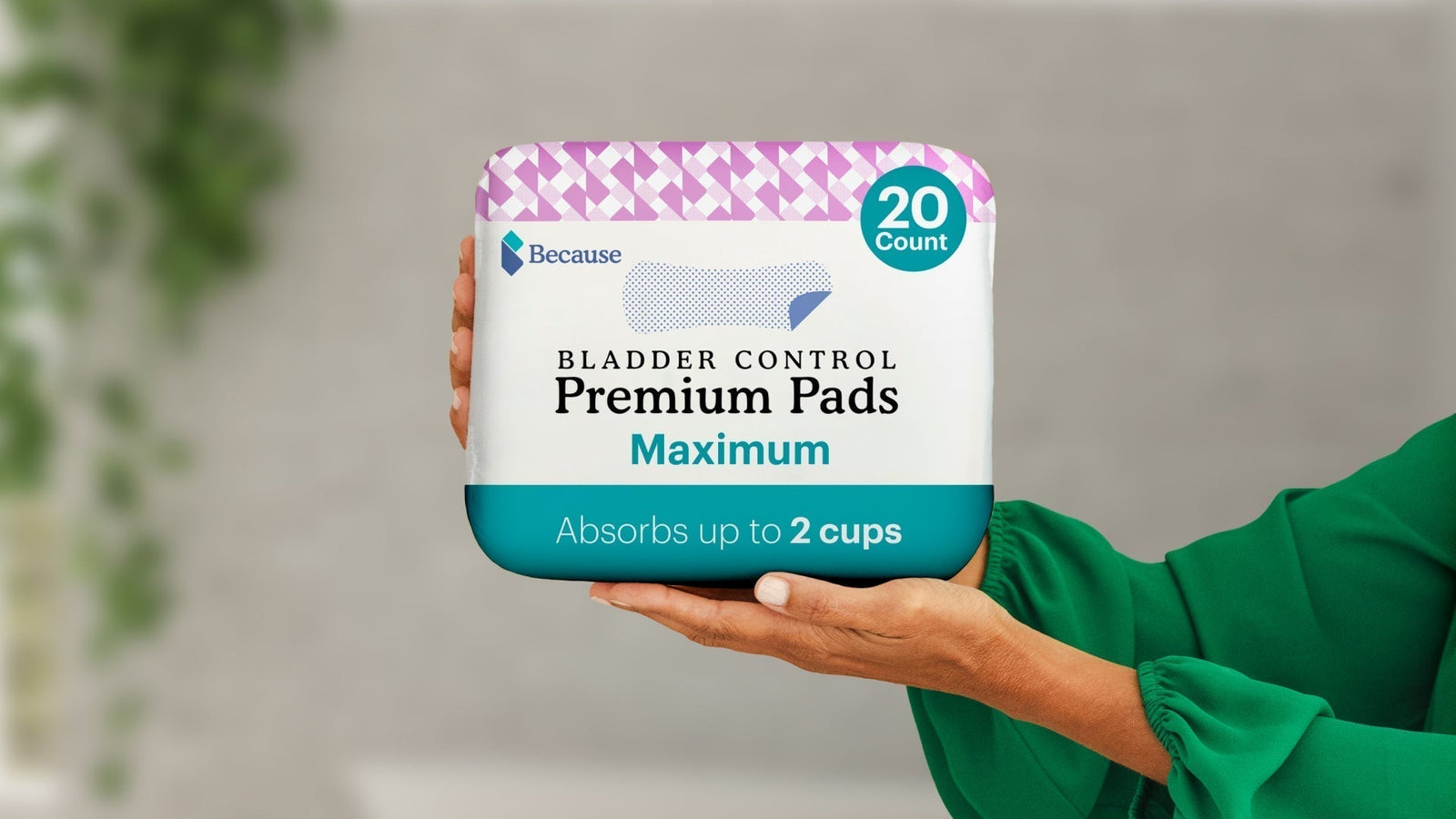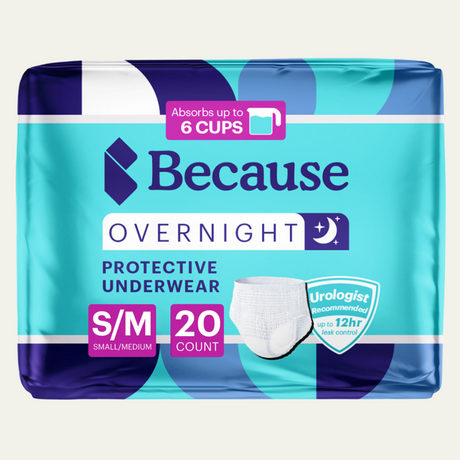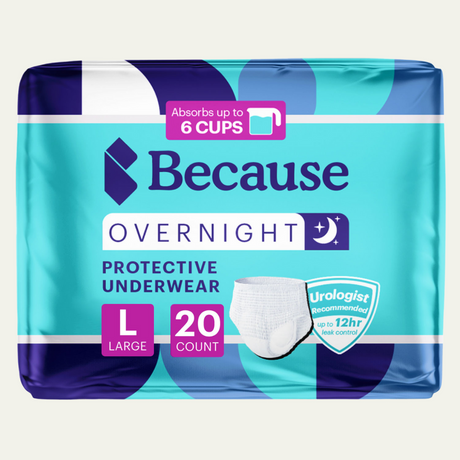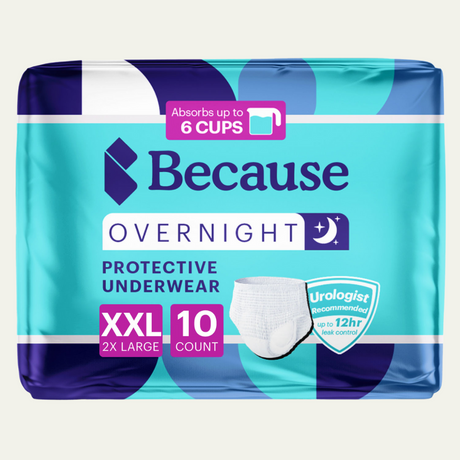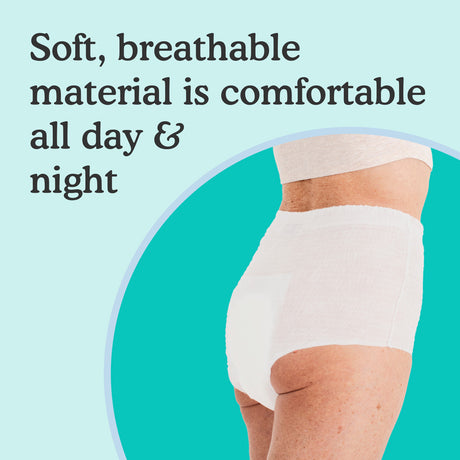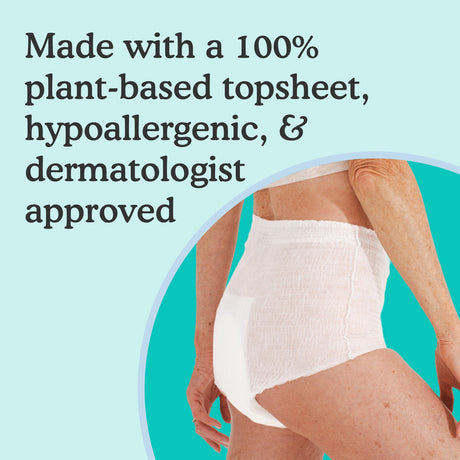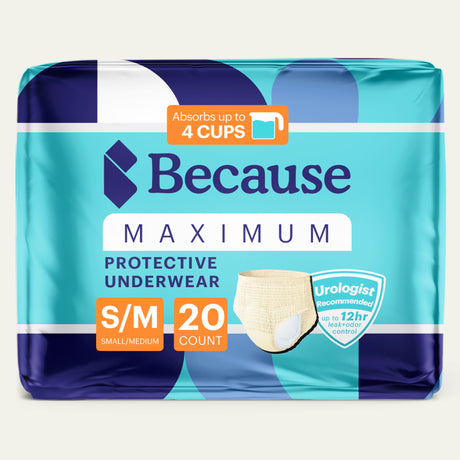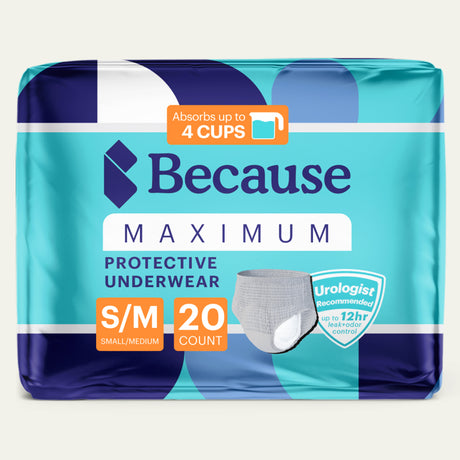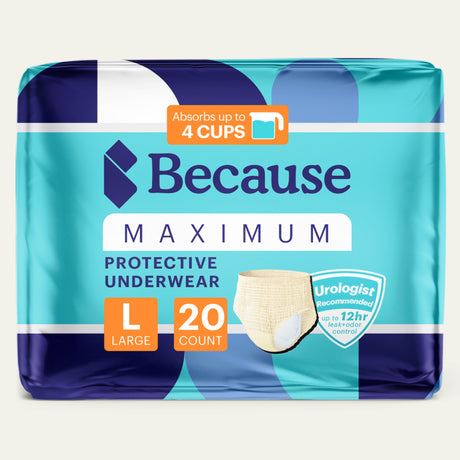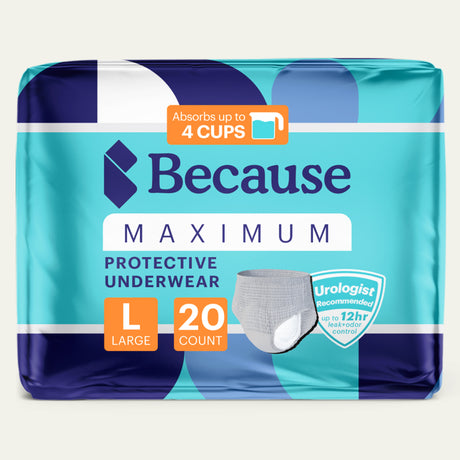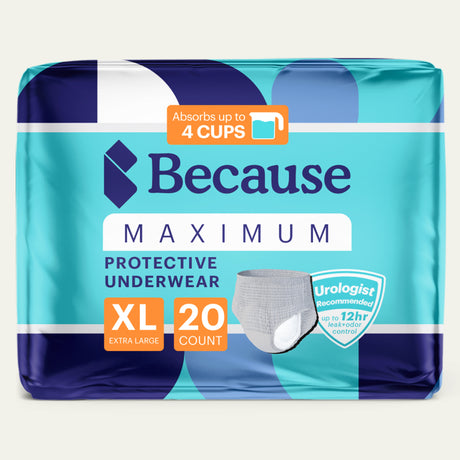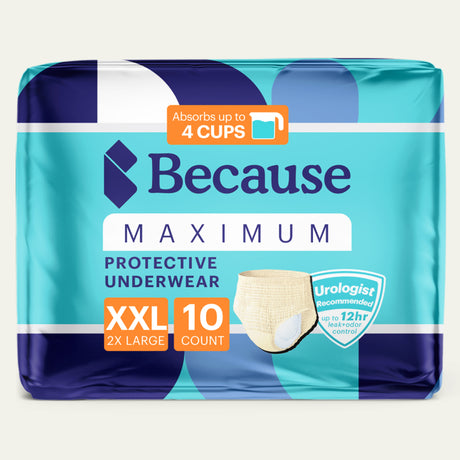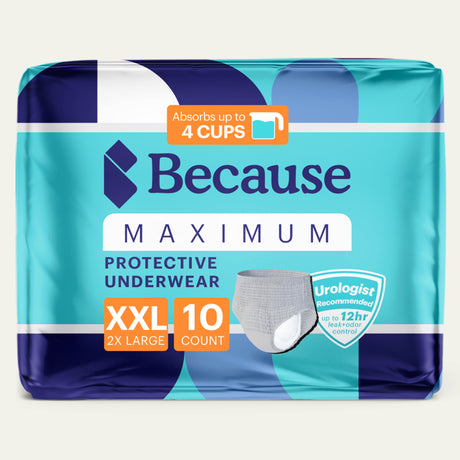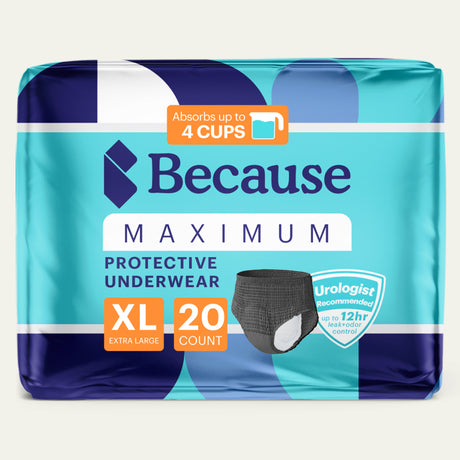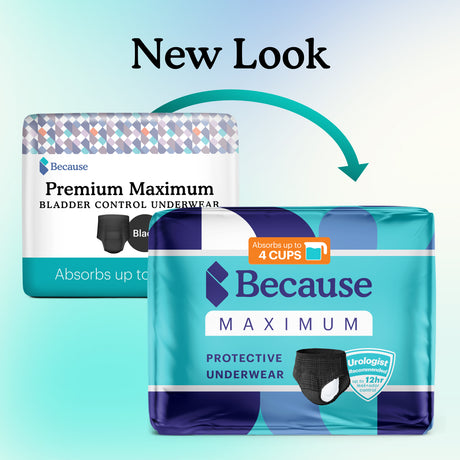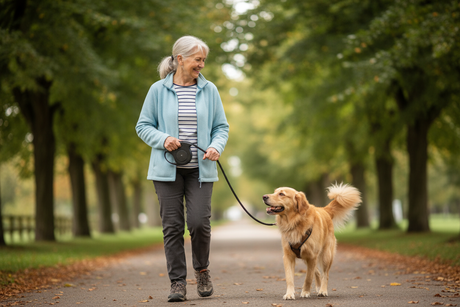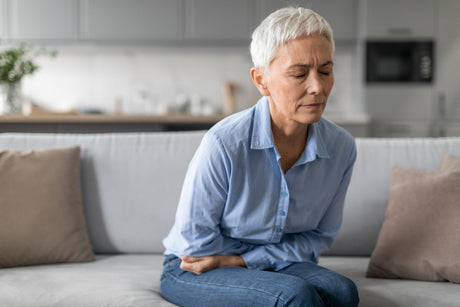At first glance, sanitary pads for menstruation and bladder control pads seem like the same thing. Women use them both as liners for underwear to prevent leaks, both pads also usually have an adhesive backing to hold them in place, and they typically come individually wrapped. In many cases, they cost a similar amount of money at the store. But despite their many similarities, absorbent pads for menstruation and urinary incontinence are different. In this post, we'll compare menstrual pads vs. incontinence pads for women and highlight their differences to help you choose the best absorbent product for your needs.
Comparing Incontinence Pads vs. Menstrual Pads
Menstrual pads and incontinence products have several differences, even though they both fit against your body and absorb bodily fluids. Let's delve into the reasons why the two types of pads differ.
Function & Purpose
The main difference between incontinence products and period pads is their function. A bladder protection pad is designed to lock away and absorb large amounts of liquid urine released rapidly, while menstrual sanitary pads or liners are intended to capture thicker blood and menstrual blood at a gradual pace. Manufacturers have introduced specific features to their designs to suit the function of each type of pad.
Absorbency
A woman's bladder can hold nearly 16 ounces of urine when completely full, and you typically feel the urge to urinate when there are around 6 to 7 ounces of fluid in your bladder. A woman may pass an ounce of urine or more at a time when a urine leak occurs. By comparison, a woman usually only produces about 1 to 1.5 ounces of menstrual fluid during an entire four to five-day period. This means incontinence pads or liners need to be more absorbent than menstrual pads to offer adequate protection.

Construction
Menstrual liners and incontinence pads are made of soft, absorbent fabrics, but their construction varies. Along with the fabric, bladder protection pads usually feature super absorbent polymers with a gel or resin core. This allows the pads to draw in more liquid and lock it away. Menstrual pads aren’t intended to hold as much liquid, so they don't need this ultra-absorbent core.

Another key difference between the sanitary pads and incontinence pads is the distribution layers. Menstrual blood and fluid are much thicker than urine and can't travel through thin membranes easily. As a result, sanitary pads usually have an open design that allows for the absorption of vaginal discharge.
Incontinence pads usually have a multi-layer design with an outer top sheet. This top sheet pulls the liquid down into the next layer when a leak occurs until the urine reaches the absorbent core. The top sheet then dries more quickly than the rest of the pad. This increases the level of comfort that you experience while wearing the bladder control pads and reduces the amount of moisture your skin comes in contact with to lower the likelihood of irritation. As a result of their layered design and top sheet, incontinence pads can play an important role in incontinence skin care, while menstrual pads generally can't.
One final difference between period pads and incontinence pads is their backing. Normally, pads designed for use as bladder protection products feature a plastic waterproof backing that acts as a final shield for undergarments. Maxi pads also have backing, but they may only be water-resistant and less effective at trapping liquid.
Odor Control
Body odors are a concern for both menstruating women and people with incontinence. To deal with this, both types of absorbent products may have odor-fighting features. However, they work differently. Some menstrual pads feature a deodorant that covers up odors. Usually, the scent comes from an added fragrance. Because some women are sensitive to synthetic fragrances, most manufacturers offer unscented pads with no odor-masking benefits.
Incontinence pads are better suited to address odors. Their polymer cores usually neutralize the pH of urine to control unpleasant scents. In addition, the top sheet promotes drier conditions near the skin. This may lower the likelihood of bacterial growth, which can worsen body odor.
Leak Protection
The ultimate purpose of absorbent products is to spare you the embarrassment of stained or wet clothing. Because of this, both menstrual sanitary pads and incontinence pads may have leak protection technology, but the specific types differ.
Some maxi pads have a different shape than incontinence pads due to the presence of side tabs called wings. Like the rest of the pad, the wings have a self-adhesive backing. When you pull off the adhesive cover, you fold the wings down over the sides of your undergarments. The purpose of the wings is to reduce the bunching up, rolling, or shifting that can allow menstrual fluid to leak out along the sides.

Wings are not an effective way to stop leaks for incontinence pads, as urine would simply spread over the wings and still leak onto undergarments. That's why bladder protection products usually feature leg guards, which are elasticated ridges that run along their sides. The elastic allows the pads to fit closely against the body, trapping urine and allowing it to become absorbed when a bladder leak occurs.
Can Incontinence Pads Be Used For Periods?
Urinary incontinence pads can be used for menstruation. However, the differences in their technology mean that thicker blood and menstrual fluid may not become fully absorbed by the incontinence pads. Depending on their absorbency level, bladder leak products may be suitable for light menstrual flow or to take the place of panty liners for capturing vaginal discharge or spotting between periods.
There is another type of incontinence protection that may provide an alternative to menstruation pads: incontinence undergarments. Also known as bladder protection underwear and incontinence briefs, these products are cloth-like disposable garments that you wear in place of conventional underwear.

Although they fit and pull on like panties, they're made of absorbent materials to protect people from both urine and feces leaks. Compared to pads, they can typically hold a lot more bodily fluids. For example, our maximum level of absorbency is capable of holding 4 cups of liquid. When incontinence pads fit properly and have the right level of absorbency, they’re unlikely to leak.
In addition to providing ample protection for incontinence sufferers, women's protective underwear design may work well for menstruation. They’re also a good option for women concerned about odors during their periods or who experience leaks when using traditional maxi pads.
Do Menstrual Pads Work for Incontinence?
Menstrual pads are typically not a good substitute for incontinence pads. They usually don't have the right absorbency level or leakage barriers to maintain urine. Plus, they lack top sheets, so moisture can build up on the surface, increasing the risk of skin irritation and odors. However, in an emergency situation where you only have access to a maxi pad, you can certainly use it rather than going without any type of pad.
What About Bladder Leaks During Your Period?
Suppose you’re concerned about bladder leaks or bladder weakness during your period. In that case, the best option for you depends on the severity of your incontinence symptoms and the characteristics of your menstrual flow. Period pads may be the right choice for very light urine leakage and heavy menstrual flow. Women prone to moderate to heavy urine leakage will typically need to use bladder control products.
As you weigh your options, talk to your doctor about your symptoms if you haven't already. A doctor can determine what type of incontinence you have or if a medical condition or medication you take is causing you to experience bladder weakness. Healthcare providers can recommend lifestyle changes, pelvic floor exercises, incontinence devices, medications, and other treatments that may ease symptoms so that you have less worry about dealing with leaks or bladder weakness during your period.
Menstrual Pads vs. Incontinence Pads: Which One Do You Need?
Whether sanitary napkins or incontinence pads are the right products for you depends on your specific needs. Maxi pads for menstruation may be the best choice if:
- You need protection during your monthly menstrual period
- You don't have any incontinence issues or experience only very light bladder leakage due to stress incontinence
Incontinence protection pads may be a better option if:
- You have any of the types of urinary incontinence and experience regular urine leakage or a partial or complete loss of bladder control
- You're especially concerned about odor control during your period and have a light flow
Incontinence underwear may be a great option if you:
- Frequently experience leaks while wearing maxi pads
- You often find it difficult to change and dispose of feminine hygiene products quickly due to travel or your lifestyle
- You have bowel incontinence
- You have urinary incontinence and prefer the convenience of pulling on protective products or prefer the feeling of wearing only undergarments
Do you or your loved one struggle with incontinence? Get a free sample pack to try today!
If you're struggling with incontinence, join one of our private support groups today!
Women's Incontinence Support Group
Men's Incontinence Support Group
Frequently Asked Questions:
Can period pads hold urine?
Period pads are designed to absorb menstrual blood, which has a thicker consistency than urine. While they can absorb small amounts of urine, they are not designed to handle the rapid flow and higher volume of urine effectively. Urine tends to spread quickly, which may cause leakage and discomfort. For better absorption, incontinence pads or adult diapers are recommended, as they are specifically designed to absorb and lock in urine.
Can you use Always Discreet pads for periods?
Always Discreet pads are designed for urinary incontinence and are more absorbent than regular menstrual pads. While they can absorb menstrual flow, they are not optimized for it, as they focus on locking in liquid quickly rather than managing the thicker consistency of menstrual blood. This may lead to discomfort, improper absorption, or leakage. For the best protection, it’s recommended to use menstrual pads specifically designed for periods.
Can you wear a pad for 8 hours?
Yes, you can wear a pad for up to 8 hours, but it depends on your flow and personal comfort. For light flow, changing every 6–8 hours may be sufficient, but for heavy flow, more frequent changes (every 3–4 hours) are recommended to prevent leaks and discomfort. Wearing a pad for too long can also increase the risk of bacterial growth and odor. It’s best to change pads regularly to maintain hygiene and prevent irritation.
Can you use Depends for your period?
It is not recommended, Depends and other incontinence products are not designed for menstrual blood and are not recommended for periods. Incontinence underwear and pads are made to absorb thin, fast-flowing urine, not the thicker consistency of menstrual blood, which can contain clots. This difference in design can lead to improper absorption, leakage, and discomfort. For the best protection, it’s recommended to use menstrual products specifically made for periods, such as pads, tampons, or menstrual cups.
Sources:
InformedHealth.org [Internet]. Cologne, Germany: Institute for Quality and Efficiency in Health Care (IQWiG); 2006-. In brief: How does the urinary system work? [Updated 2022 Mar 29]. Available from: https://www.ncbi.nlm.nih.gov/books/NBK279384/
Centers for Disease Control and Prevention. (2024, May 15). About Heavy Menstrual Bleeding. U.S. Department of Health & Human Services. Retrieved from https://www.cdc.gov/female-blood-disorders/about/heavy-menstrual-bleeding.html
